A history: rabbits as pet, pest, and product
"Domestic rabbits are one of
the few pets that can be enjoyed dead or alive..."
- Life Magazine, January 4, 1943
Introduction:
Rabbits are unique in Western culture as one of the few animals that are loved as pets, despised as pests, and still bred as product for the meat, fur and lab animal industries. While dogs and cats are allowed to roam freely in our homes, the privileged relationship we have with them as pets has not been extended as fully or completely to many pet rabbits. And, where many people are appalled at factory farming conditions for chickens, calves and pigs, very few know that the same problems are replicated within the meat rabbit industry. Rabbits inhabit a cultural limbo in the animal welfare world: as domesticated farm animals they are somehow less worthy of respect and care than either the more familiar pets or the more exotic wild animals; but they are frequently overlooked by farm animal protection groups because they form only a small fraction of the meat industry.
Some of the animal welfare/animal rights issues facing rabbits
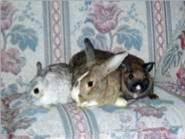
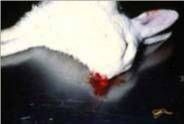

Pet Pest Product
Rabbits as pets: the pet industry
"I like rabbits, I've just
never really cared about them"
- "Stories Rabbits Tell" Susan E. Davis & Margo Demello 2003
Did you know...
Rabbits are much more common as pets than people realize, anywhere between the 3rd and the 5th most popular pet in the US, Europe, parts of the Antipodes and Japan, with estimates of over 5 million pet rabbits living in the US alone.
Hundreds of rabbits are seized, surrendered or brought to BC shelters alone. Some of the most common reasons for rabbits being surrendered to shelters include: Moving; Kids lost interest; Don't have time; Can't take care of any more; Wasn't mine originally and now I don't want it; Don't know how to take care of it; Messy; Had babies.
Where do these unwanted
rabbits come from?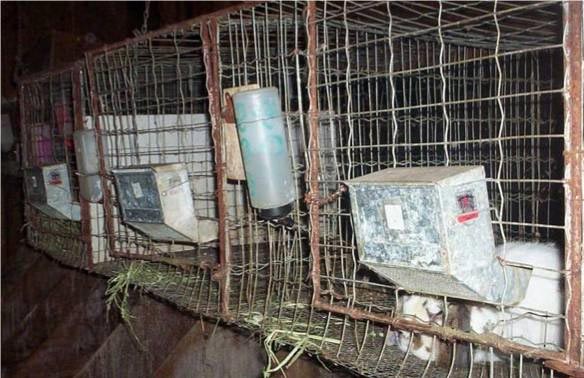
While people are familiar with puppy mills, most are unfamiliar with bunny mills, rabbitries that produce kits for transportation and sale to retailers, either directly or through brokers. In addition to these large scale operations, there are also a number of breeders of show rabbits who sell stock as either show or pet quality.
There are close to 30 BC rabbit breeders advertising rabbits for sale on the internet, and this figure would increase exponentially if we took into account people who do not advertise on the internet but who sell through ads, and people who have rabbits who simply put up notices at their houses.
While many breeders are
careful to note their affiliation with the American Rabbit Breeders Association
and show at least some concern for the rabbits they sell, others seem less
careful.

At least one breeder advertised the fact she culled heavily. For show breeders culling is an inevitable part of raising rabbits. Those who are small, sick, do not conform to colour or shape are killed, used as meat or reptile bait or sold as pet stock. If breeders cull extensively, as some commercial pet breeders do, upward of 90-95% of rabbits can be culled.
Other breeders were selling "pet quality" stock because the rabbit had visible medical problems (a spot in their eye), because they were "unsuitable" (could not produce live kits after two attempts), or were older breeding stock.
At least one Canadian breeder had issued a warning on her web site about another breeder who had sold stock rabbits that were clearly sick or who died within a short time after transportation. These are just small examples of larger problems with the ethics of breeding for profit.
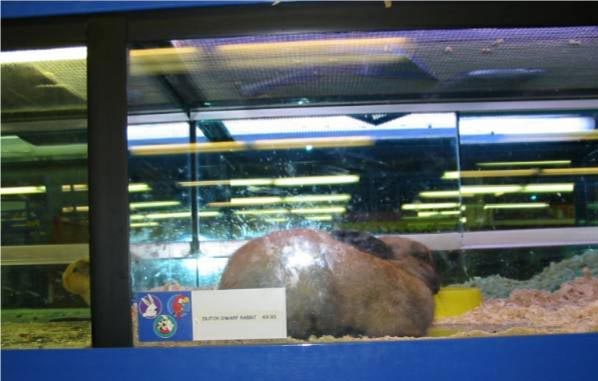 Figures
from the US suggest that while our examples are small they are typical and
indicative of large scale problems with pet industry.
Figures
from the US suggest that while our examples are small they are typical and
indicative of large scale problems with pet industry.
It is generally assumed that 20-30% of young rabbits destined for pet stores will die in transportation, that more will die once they are in the stores and that some who survive the store will still die once they reach their new home. Both US and UK newspapers have featured stories about the inhumane treatment excess or sick pet store rabbits receive, including suffocation and beating to death.
Problems with the treatments animals receive as pet store product are endemic and widely reported and are particularly pertinent to rabbits as appropriate standards of care and treatment are less well known and as rabbits are adept at hiding illness.
Rabbits as pest: the problems with pesticide
"All the arguments to prove
man's superiority cannot shatter this hard fact: in suffering the animals are
our equals."
- Peter Singer, Ira W. DeCamp Professor of Bioethics of Princeton's Center for
Human Values
Domestic European rabbits were introduced to Australia and New Zealand in the later eighteenth century; a hundred years later they had proliferated so widely farmers were being forced to leave their farms. The most famous response of the Australian government to this population explosion was the Rabbit Proof Fence, a 2,000 mile long fence running across the country built at the beginning of the twentieth century. Unchecked there is little doubt that rabbits can create immense damage particularly to cultivated lands. So what happens when rabbits and agricultural - or human - interests collide?
Innumerable method have been used to deplete rabbit populations including the introduction of natural predators, trapping, gassing, rabbit drives (where thousands of rabbits are driven into corrals and then bludgeoned), poisoning, fumigation with cyanide powder and fencing. Recent attempts have included the introduction of fatal viral agents into rabbit populations.
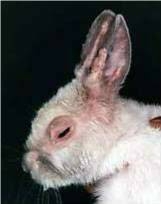 The
first attempt at biological control was the myxoma virus, which Australia
introduced into its rabbit population in the 1950s. Some of the symptoms of
myxomatosis include swelling in eyes, ears, mouth, nose, genitals, high fevers,
seizures, and hemorrhaging, with death resulting from a range of infections,
liver disease, or the inability of animals blinded by the disease to defend
themselves from predation.
The
first attempt at biological control was the myxoma virus, which Australia
introduced into its rabbit population in the 1950s. Some of the symptoms of
myxomatosis include swelling in eyes, ears, mouth, nose, genitals, high fevers,
seizures, and hemorrhaging, with death resulting from a range of infections,
liver disease, or the inability of animals blinded by the disease to defend
themselves from predation.
The initial introduction of the virus in Australia eliminated approximately 99% of the wild rabbit population in areas it was released, although it was less successful in New Zealand. Myxoma virus was similarly introduced to France in 1952 where it killed 98% of wild and 40% of domestic rabbits, and quickly spread throughout Europe and England.
A key problem with the introduction of the myxoma virus was, ironically, its success rate: myxomatosis can spread so rapidly that ecological chains can be affected because many predators are dependent on rabbits as food. In Britain, for example, while grasses flourished small animal populations dropped due to increase predation by birds, foxes, stoats and weasels.
 The
most recent and most controversial of biological control measures is rabbit
hemorrhagic disease (RHD), also called rabbit calicivirus, or viral hemorrhagic
disease (VHD). As the USDA's APHIS web site indicates, the disease was first
seen in China in the mid 1980s and has since been reported in Mexico, Cuba, the
USA and approximately 37 other countries, with a mortality rate of up to 90%.
The
most recent and most controversial of biological control measures is rabbit
hemorrhagic disease (RHD), also called rabbit calicivirus, or viral hemorrhagic
disease (VHD). As the USDA's APHIS web site indicates, the disease was first
seen in China in the mid 1980s and has since been reported in Mexico, Cuba, the
USA and approximately 37 other countries, with a mortality rate of up to 90%.
While RHD has never been formally released, in the mid 1990s it managed to "travel" from an Australian experimental facility on Wardang Island and within a space of two months had eradicated upward of ten million rabbits on the mainland. Two years later, contrary to government recommendations, New Zealand farmers imported the disease and, unable to stop the spread, the New Zealand government subsequently legalized the spread of RHD.
A major concern about RHD is the inherent mutability and instability of caliciviruses, including their ability to jump species. While there is a French vaccine for RHD, the ability of viruses to mutate beyond the abilities of the vaccine to control suggests due caution be used in inter species biological warfare.
Rabbits as product: meat and fur
"I look into the sweet brown
eyes of an adorable rabbit and think SLIPPERS!
- "Stories Rabbits Tell" Susan E. Davis & Margo Demello 2003
"...the time will come when
men such as I will look upon murder of animals as they look upon the murder of
men."
- Leonardo Da Vinci
As part of its investigations into the 2000 outbreak of rabbit calicivirus the US government indicated the US commercial rabbit industry was worth about 25 million dollars, 60% of which came from laboratory uses. While this dollar amount is small in comparison to commercially raised beef or chicken, farmed rabbits suffer in exactly the same way as other intensively reared animals do.
During the 1960s and 70s European producers experimented by housing thousands of rabbits together. Implementing changes to lighting, using artificial insemination and hormone treatments, trying artificial insemination, and weaning kits early to increase the amounts of times does could be bred in a year were some of the techniques used to boost production rates.
 Most
rabbit meat breeders in Canada are small scale operations with less than 100
breeding does. We were able to locate approximately a dozen meat breeders
throughout BC, a number of whom also raised show or pet rabbits; several meat
breeders also sold meat stock as pets, and frozen rabbit meat as snake food.
Most
rabbit meat breeders in Canada are small scale operations with less than 100
breeding does. We were able to locate approximately a dozen meat breeders
throughout BC, a number of whom also raised show or pet rabbits; several meat
breeders also sold meat stock as pets, and frozen rabbit meat as snake food.
Common injuries seen in the intensively farmed rabbits include damage to paws and hocks because of the use of metal grating for flooring, spinal damage because of crowding in cages, complicated by respiratory and infectious diseases of various kinds as rabbits are packed six or more to a cage and housed row upon row and layer upon layer in living meat warehouses.
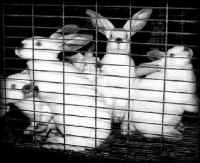 If
life in the rabbitry is unpleasant, the transport for slaughter can be even
worse. Many rabbits have to endure hours of transport to the slaughter house.
If
life in the rabbitry is unpleasant, the transport for slaughter can be even
worse. Many rabbits have to endure hours of transport to the slaughter house.
They travel in crates between six and eleven inches high that are crammed with as many as eight rabbits and, like chickens, they are then stacked on a truckbed with hundreds of other rabbits.
Deaths from stress and injury are common and slaughtering methods are uncertain, with some rabbits most certainly being left alive and conscious prior to being hung and having their throats cut to "bleed out."


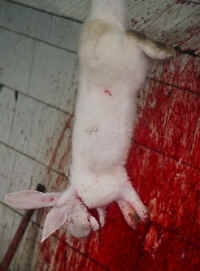
 The
most recent attempts to increase rabbit meat production have been seen in the
Third World where development agencies promote the rabbit as a tool to
self-sufficiency and as a fast and easy source of renewable meat.
The
most recent attempts to increase rabbit meat production have been seen in the
Third World where development agencies promote the rabbit as a tool to
self-sufficiency and as a fast and easy source of renewable meat.
 Organizations
promoting rabbit meat projects include the United Nations and The Peace Corps,
and programs can be found in Ghana, Tanzania, Kenya, the Philippines, Costa
Rica, El Salvador, Indonesia, Vietnam and other countries. Many of these
programs focus on women farmers.
Organizations
promoting rabbit meat projects include the United Nations and The Peace Corps,
and programs can be found in Ghana, Tanzania, Kenya, the Philippines, Costa
Rica, El Salvador, Indonesia, Vietnam and other countries. Many of these
programs focus on women farmers.
Some breeders suggest fur production is simply a "by-product" of meat production. Although the pelts from fryers can be used for trim, better fur can be obtained from a mature rabbit. Most rabbit fur is obtained from Europe or China but very little is known about the specifics of the rabbit fur industry as most fur industry focus have been on foxes, mink, or endangered species. What has become apparent is that rabbits are not the only pet animals that are slaughtered for their fur and recent years have seen campaigns around the slaughter of domestic dogs and cats in places like the East, but little mention is made of the millions of rabbits killed.
Rabbits as product: for the sake of science
"I abhor vivisection with my whole soul. I detest the unpardonable slaughter of innocent life in the name of science, and of humanity so-called, and all the scientific discoveries stained with innocent blood I count of no consequence." Mahatma Gandhi, 1869 - 1948
 Rabbits
have been used as test animals in experimental science since the nineteenth
century but were not bred for the industry until the twentieth century. These
days specialized breeding facilities can provide "Pathogen Free" rabbits raised
in sterile conditions, or "Barrier Specific" rabbits who are not only raised in
sterile conditions but are born by cesarean section to avoid contamination from
bacteria in the birth canal.
Rabbits
have been used as test animals in experimental science since the nineteenth
century but were not bred for the industry until the twentieth century. These
days specialized breeding facilities can provide "Pathogen Free" rabbits raised
in sterile conditions, or "Barrier Specific" rabbits who are not only raised in
sterile conditions but are born by cesarean section to avoid contamination from
bacteria in the birth canal.
 One
of the most common uses for rabbits has been product testing. One of the most
infamous tests used on rabbits is the Draize Eye Irritancy Test (DEIT), which
measures how chemicals affect the eyes.
One
of the most common uses for rabbits has been product testing. One of the most
infamous tests used on rabbits is the Draize Eye Irritancy Test (DEIT), which
measures how chemicals affect the eyes.
The rabbit to be placed in a stock with its head immobilized, the eye is held open with a clip, and the substance is placed in one eye. The amount of tissue damage that occurs over the following days or weeks is then measured, and at the end of the experiment the rabbits are killed. Rabbits have been used in medical research to study herpes, ovulation, immunology, embryology and other areas and most famously, the "rabbit test" for pregnancy.
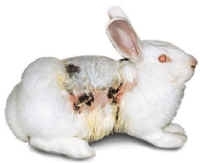 CCAC
statistics on rabbits used in research in Canada indicate a downward trend in
the number of rabbits used for experimental purposes. Still, more than fourteen
thousand rabbits were used across Canada in 2001, approximately 30% of which
were used in studies causing moderate to severe distress. More than three
thousand of these rabbits were used in the Western Provinces
CCAC
statistics on rabbits used in research in Canada indicate a downward trend in
the number of rabbits used for experimental purposes. Still, more than fourteen
thousand rabbits were used across Canada in 2001, approximately 30% of which
were used in studies causing moderate to severe distress. More than three
thousand of these rabbits were used in the Western Provinces
"Until we extend our circle
of compassion to all living things, humanity will not find peace."
- Albert Schweitzer, 1875 - 1965
- July,
2005
Carmina Gooch
Sue Collard -
Rabbit Advocacy Group of BC
Vancouver, BC, Canada